A Review of Key Factors Affecting the Wear Performance of Medium Manganese Steels
Abstract
1. Introduction
2. Wear Testing and Characterisation Methods
3. Wear Testing Results
4. Wear Mechanism
5. Phase Constitution and Microstructure
5.1. TRIP and TWIP Effect
5.1.1. Austenite
5.1.2. Martensite
5.1.3. Ferrite
5.2. Effects of Alloy Elements
5.3. Effect of Heat Treatment
5.3.1. IA
5.3.2. Quenching plus IA
5.3.3. Quenching plus Tempering
5.3.4. Quenching plus Partitioning
5.3.5. Cold Rolled plus IA
5.3.6. Deep Cryogenic Treatment plus IA
6. Conclusions
7. Outlook
- Abrasive wear, adhesive wear, fatigue wear and impact wear have been studied in MMSs, while corrosive wear—another common form of wear in mining environments—has received less attention. Future exploration of the corrosion resistance of MMSs may provide valuable insights into their suitability for applications in mining equipment;
- Although the effects of heating temperature and soaking time in heat treatment have been studied, the effect of cooling rate during heat treatment has been relatively overlooked. The cooling rate plays a critical role in determining the formation of different phases in MMSs, and further investigation into its impact on the wear performance of MMSs is thus indispensable;
- As MMSs start to popularise their application in the mining industry, abrasive media such as coal, coal gangue and quartz sand, which are highly related to the external environmental conditions, need to be incorporated in the wear testing of MMSs;
- Bimetal composites combine the excellent wear resistance of MMSs with satisfying mechanical properties of mild steels for the purpose of reducing the entire material cost but ensuring required overall performance. Therefore, they can be considered for use in mining equipment such as the scraper conveyor and mining truck.
Author Contributions
Funding
Data Availability Statement
Conflicts of Interest
Nomenclature
| wear rate | |
| wear weight | |
| material density | |
| total impact multiplied | |
| scratch hardness | |
| fracture strain | |
| austenite volume fraction | |
| austenite diffraction peak | |
| martensite diffraction peak | |
| austenite deformation force | |
| contents of carbon | |
| contents of Mn | |
| Kelvin temperature | |
| austenite fraction before deformation | |
| austenite fraction after strained | |
| mechanical stability coefficient | |
| martensite start temperature | |
| a | empirical fitting constants |
| b | empirical fitting constants |
| martensite fraction | |
| m | martensite grain length to width ratio |
| contents of Si | |
| contents of Al | |
| average austenite grain volume | |
| kinetic correlation constants | |
| kinetic correlation constants | |
| MMS | medium manganese steel |
| TRIP | transformation induced plasticity |
| TWIP | twinning induced plasticity |
| IA | intercritical annealing |
| DCT | deep cryogenic treatment |
| SFE | stacking fault energy |
| XRD | X-ray diffraction |
| EBSD | electron backscatter diffraction |
| MMMS | medium manganese martensitic steel |
| FRT | finish rolling temperature |
| MMAS | medium manganese austenitic steel |
| MWRS | martensitic wear-resistant steel |
References
- He, Z.; Qi, C.; Fu, S.; Xie, J. Improved work-hardening ability and wear resistance of austenitic manganese steel under non-severe impact-loading conditions. Wear 1987, 120, 305–319. [Google Scholar] [CrossRef]
- Chen, H.; Zhao, D.; Wang, Q.; Qiang, Y.; Qi, J. Effects of impact energy on the wear resistance and work hardening mechanism of medium manganese austenitic steel. Friction 2017, 5, 447–454. [Google Scholar] [CrossRef]
- Wang, J.; Wang, Q.; Zhang, X.; Zhang, D. Impact and Rolling Abrasive Wear Behavior and Hardening Mechanism for Hot-Rolled Medium-Manganese Steel. J. Tribol. 2018, 140. [Google Scholar] [CrossRef]
- Yan, X.; Hu, J.; Wang, L.; Chai, Z.; Sun, W.; Xu, W. The coupled effect of thermal and mechanical stabilities of austenite on the wear resistance in a 0.2C–5Mn-1.6Si steel down to cryogenic temperatures. Wear 2021, 486–487. [Google Scholar] [CrossRef]
- Yan, X.; Hu, J.; Yu, H.; Wang, C.; Xu, W. Unraveling the significant role of retained austenite on the dry sliding wear behavior of medium manganese steel. Wear 2021, 476. [Google Scholar] [CrossRef]
- Ge, S.; Wang, Q.; Wang, J. The impact wear-resistance enhancement mechanism of medium manganese steel and its applications in mining machines. Wear 2017, 376–377, 1097–1104. [Google Scholar] [CrossRef]
- Chen, S.-c.; Ye, H.-x.; Lin, X.-q. Effect of rare earth and alloying elements on the thermal conductivity of austenitic medium manganese steel. Int. J. Miner. Metall. Mater. 2017, 24, 670–674. [Google Scholar] [CrossRef]
- Rendón, J.; Olsson, M. Abrasive wear resistance of some commercial abrasion resistant steels evaluated by laboratory test methods. Wear 2009, 267, 2055–2061. [Google Scholar] [CrossRef]
- Chen, H.; Guo, H.; Shang, C.J. Study on wear behaviours of 400 and 450 grade wear resistant steels. Mater. Res. Innov. 2014, 18, S4-270-S274-275. [Google Scholar] [CrossRef]
- Jost, N.; Schmidt, I. Friction-induced martensitic transformation in austenitic manganese steels. Wear 1986, 111, 377–389. [Google Scholar] [CrossRef]
- Gibbs, P.J.; De Cooman, B.C.; Brown, D.W.; Clausen, B.; Schroth, J.G.; Merwin, M.J.; Matlock, D.K. Strain partitioning in ultra-fine grained medium-manganese transformation induced plasticity steel. Mater. Sci. Eng. A 2014, 609, 323–333. [Google Scholar] [CrossRef]
- Latypov, M.I.; Shin, S.; De Cooman, B.C.; Kim, H.S. Micromechanical finite element analysis of strain partitioning in multiphase medium manganese TWIP+TRIP steel. Acta Mater. 2016, 108, 219–228. [Google Scholar] [CrossRef]
- Lee, S.; Lee, K.; De Cooman, B.C. Observation of the TWIP + TRIP Plasticity-Enhancement Mechanism in Al-Added 6 Wt Pct Medium Mn Steel. Metall. Mater. Trans. A 2015, 46, 2356–2363. [Google Scholar] [CrossRef]
- Zou, Y.; Xu, Y.B.; Hu, Z.P.; Gu, X.L.; Peng, F.; Tan, X.D.; Chen, S.Q.; Han, D.T.; Misra, R.D.K.; Wang, G.D. Austenite stability and its effect on the toughness of a high strength ultra-low carbon medium manganese steel plate. Mater. Sci. Eng. A 2016, 675, 153–163. [Google Scholar] [CrossRef]
- Lee, S.; De Cooman, B.C. Annealing Temperature Dependence of the Tensile Behavior of 10 pct Mn Multi-phase TWIP-TRIP Steel. Metall. Mater. Trans. A 2014, 45, 6039–6052. [Google Scholar] [CrossRef]
- Cai, Z.H.; Ding, H.; Xue, X.; Xin, Q.B. Microstructural evolution and mechanical properties of hot-rolled 11% manganese TRIP steel. Mater. Sci. Eng. A 2013, 560, 388–395. [Google Scholar] [CrossRef]
- Jacques, P.J.; Delannay, F.; Ladrière, J. On the influence of interactions between phases on the mechanical stability of retained austenite in transformation-induced plasticity multiphase steels. Metall. Mater. Trading A 2001, 32A, 2759–2768. [Google Scholar] [CrossRef]
- Lee, S.; De Cooman, B.C. On the Selection of the Optimal Intercritical Annealing Temperature for Medium Mn TRIP Steel. Metall. Mater. Trans. A 2013, 44, 5018–5024. [Google Scholar] [CrossRef]
- Nakada, N.; Mizutani, K.; Tsuchiyama, T.; Takaki, S. Difference in transformation behavior between ferrite and austenite formations in medium manganese steel. Acta Mater. 2014, 65, 251–258. [Google Scholar] [CrossRef]
- Yan, N.; Di, H.; Misra, R.D.K.; Huang, H.; Li, Y. Enhancing austenite stability in a new medium-Mn steel by combining deep cryogenic treatment and intercritical annealing: An experimental and theoretical study. Mater. Sci. Eng. A 2019, 753, 11–21. [Google Scholar] [CrossRef]
- Wei, R.; Enomoto, M.; Hadian, R.; Zurob, H.S.; Purdy, G.R. Growth of austenite from as-quenched martensite during intercritical annealing in an Fe–0.1C–3Mn–1.5Si alloy. Acta Mater. 2013, 61, 697–707. [Google Scholar] [CrossRef]
- Yang, F.; Luo, H.; Hu, C.; Pu, E.; Dong, H. Effects of intercritical annealing process on microstructures and tensile properties of cold-rolled 7Mn steel. Mater. Sci. Eng. A 2017, 685, 115–122. [Google Scholar] [CrossRef]
- Han, J.; Lee, Y.-K. The effects of the heating rate on the reverse transformation mechanism and the phase stability of reverted austenite in medium Mn steels. Acta Mater. 2014, 67, 354–361. [Google Scholar] [CrossRef]
- Lee, S.; De Cooman, B.C. Tensile Behavior of Intercritically Annealed 10 pct Mn Multi-phase Steel. Metall. Mater. Trans. A 2013, 45, 709–716. [Google Scholar] [CrossRef]
- Han, J.; Lee, S.-J.; Lee, C.-Y.; Lee, S.; Jo, S.Y.; Lee, Y.-K. The size effect of initial martensite constituents on the microstructure and tensile properties of intercritically annealed Fe–9Mn–0.05C steel. Mater. Sci. Eng. A 2015, 633, 9–16. [Google Scholar] [CrossRef]
- Han, J.; Lee, S.-J.; Jung, J.-G.; Lee, Y.-K. The effects of the initial martensite microstructure on the microstructure and tensile properties of intercritically annealed Fe–9Mn–0.05C steel. Acta Mater. 2014, 78, 369–377. [Google Scholar] [CrossRef]
- Spero, C.D.J.R.K.; Hargreaves, D.J.; Kirkcaldie, R.K.; Flitt, H.J. Review of test methods for abrasive wear in ore grinding. Wear 1991, 146, 389–408. [Google Scholar] [CrossRef]
- Jonczy, I.; Wieczorek, A.N.; Podwórny, J.; Gerle, A.; Staszuk, M.; Szwebllk, J. Characteristics of hard coal and its mixtures with water subjected to friction. Miner. Resour. Manag. 2020, 36, 185–202. [Google Scholar] [CrossRef]
- Hao, J.; Song, Y.; Zhang, P.; Liu, H.; Jia, S.; Zheng, Y.; Zhang, X. Failure analysis of scraper conveyor based on fault tree and optimal design of new scraper with polyurethane material. J. Mater. Res. Technol. 2022, 18, 4533–4548. [Google Scholar] [CrossRef]
- Wang, S.P.; Yang, Z.J. Improve Design and Analysis on Transitional Chute of Scraper Conveyor. Adv. Mater. Res. 2010, 145, 541–545. [Google Scholar] [CrossRef]
- Wieczorek, A.N.; Wójcicki, M. Synergism of the Binary Wear Process of Machinery Elements Used for Gaining Energy Raw Materials. Energies 2021, 14, 1981. [Google Scholar] [CrossRef]
- Ojala, N.; Valtonen, K.; Heino, V.; Kallio, M.; Aaltonen, J.; Siitonen, P.; Kuokkala, V.-T. Effects of composition and microstructure on the abrasive wear performance of quenched wear resistant steels. Wear 2014, 317, 225–232. [Google Scholar] [CrossRef]
- Li, J.; Liang, S. Friction and wear of the middle trough in scraper conveyors. Ind. Lubr. Tribol. 2018, 70, 1072–1077. [Google Scholar] [CrossRef]
- Stachowiak, A.; Wieczorek, A.N. Comparative tribocorrosion tests of 30CrMo12 cast steel and ADI spheroidal cast iron. Tribol. Int. 2021, 155. [Google Scholar] [CrossRef]
- Wang, Q.; Meng, L.; Chen, H.; Zheng, Q. Study on Tribological Properties of a New Fe3Al-Based Alloy as an Alternative Material for Scraper Conveyor. J. Tribol. 2021, 143. [Google Scholar] [CrossRef]
- Morshed, A.; Wu, H.; Jiang, Z. A Comprehensive Review of Water-Based Nanolubricants. Lubricants 2021, 9, 89. [Google Scholar] [CrossRef]
- Shi, Z.; Zhu, Z. Case study: Wear analysis of the middle plate of a heavy-load scraper conveyor chute under a range of operating conditions. Wear 2017, 380–381, 36–41. [Google Scholar] [CrossRef]
- Xia, R.; Li, B.; Wang, X.; Yang, Z.; Liu, L. Screening the Main Factors Affecting the Wear of the Scraper Conveyor Chute Using the Plackett–Burman Method. Math. Probl. Eng. 2019, 2019, 1–11. [Google Scholar] [CrossRef]
- Sundström, A.; Rendóna, J.; Olsson, M. Wear behaviour of some low alloyed steels under combined impact/abrasion contact conditions. Wear 2001, 250, 744–754. [Google Scholar] [CrossRef]
- Han, R.; Yang, G.; Xu, D.; Zhao, G.; Zhu, X.; Li, S. Dry sliding wear behaviour of hot-rolled air-cooled medium manganese martensitic steel. Mater. Sci. Technol. 2023, 39, 1137–1145. [Google Scholar] [CrossRef]
- Wang, Q.; Wang, J. Investigation of Wear Property and Strengthening Mechanism of Hot-Rolled Medium Manganese Steel on Condition of Slurry Erosion Wear. J. Tribol. 2022, 145. [Google Scholar] [CrossRef]
- Tan, N.; Qiao, J.; Wang, Q. Tribocorrosion performance of medium-manganese austenitic wear-resistant steel in simulated mine water. Corros. Sci. 2023, 219, 111225. [Google Scholar] [CrossRef]
- Yan, X.; Hu, J.; Zhang, X.; Xu, W. Macroscopic and nanoscale investigation of the enhanced wear properties of medium-Mn steel processed via room-temperature quenching and partitioning. Wear 2023, 522, 204711. [Google Scholar] [CrossRef]
- Cai, Z.H.; Wang, S.K.; Zhou, Y.J.; Dong, J.Y.; Ma, L.F.; Liu, S.L. Influence of aging treatment on mechanical properties and wear resistance of medium manganese steel reinforced with Ti(C,N) particles. Friction 2023. [Google Scholar] [CrossRef]
- Cai, Z.; Wang, S.; Zhou, Y.; Dong, J.; Yu, C.; Ma, L. The synergistic effect of grain refinement and precipitation strengthening on mechanical properties and dry sliding wear behavior of medium manganese steels. Tribol. Int. 2023, 179, 108158. [Google Scholar] [CrossRef]
- Gates, J.D. Two-body and three-body abrasion A critical discussion. Wear 1998, 214, 139–146. [Google Scholar] [CrossRef]
- Hokkirigawa, K.; Kato, K. An experimental and theoretical investigation of ploughing, cutting and wedge formation during abrasive wear. Tribol. Int. 1988, 21, 51–57. [Google Scholar] [CrossRef]
- Yao, Y.; Liu, W.; Gao, Z. Impact damage to the middle trough of a scraper conveyor based on the engineering discrete element method and orthogonal matrix analysis. PLoS ONE 2022, 17, e0266831. [Google Scholar] [CrossRef]
- Zhang, P.; Li, B.; Wang, X.; Liu, C.; Bi, W.; Ma, H. The Loading Characteristics of Bulk Coal in the Middle Trough and Its Influence on Rigid Body Parts. Stroj. Vestn. J. Mech. Eng. 2020, 114–126. [Google Scholar] [CrossRef]
- Wu, H.; Jia, F.; Li, Z.; Lin, F.; Huo, M.; Huang, S.; Sayyar, S.; Jiao, S.; Huang, H.; Jiang, Z. Novel water-based nanolubricant with superior tribological performance in hot steel rolling. Int. J. Extrem. Manuf. 2020, 2. [Google Scholar] [CrossRef]
- Wu, H.; Kamali, H.; Huo, M.; Lin, F.; Huang, S.; Huang, H.; Jiao, S.; Xing, Z.; Jiang, Z. Eco-Friendly Water-Based Nanolubricants for Industrial-Scale Hot Steel Rolling. Lubricants 2020, 8, 96. [Google Scholar] [CrossRef]
- Tomota, Y.; Tokuda, H.; Adachi, Y.; Wakita, M.; Minakawa, N.; Moriai, A.; Morii, Y. Tensile behavior of TRIP-aided multi-phase steels studied by in situ neutron diffraction. Acta Mater. 2004, 52, 5737–5745. [Google Scholar] [CrossRef]
- Bellhouse, E.M.; McDermid, J.R. Effect of Continuous Galvanizing Heat Treatments on the Microstructure and Mechanical Properties of High Al-Low Si Transformation Induced Plasticity Steels. Metall. Mater. Trans. A 2010, 41, 1460–1473. [Google Scholar] [CrossRef]
- Jacques, P.; Furnémont, Q.; Mertens, A.; Delannay, F. On the sources of work hardening in multiphase steels assisted by transformation-induced plasticity. Philos. Mag. A 2001, 81, 1789–1812. [Google Scholar] [CrossRef]
- Girault, E.; Jacques, P.; Harlet, P.; Mols, K.; Van Humbeeck, J.; Aernoudt, E.; Delannay, F. Metallographic Methods for Revealing the Multiphase Microstructure of TRIP-Assisted Steels. Mater. Charact. 1998, 40, 111–118. [Google Scholar] [CrossRef]
- García-Mateo, C.; Caballero, F.G. The Role of Retained Austenite on Tensile Properties of Steels with Bainitic Microstructures. Mater. Trans. 2005, 46, 1839–1846. [Google Scholar] [CrossRef]
- Lee, S.; De Cooman, B.C. Effect of the Intercritical Annealing Temperature on the Mechanical Properties of 10 Pct Mn Multi-phase Steel. Metall. Mater. Trans. A 2014, 45, 5009–5016. [Google Scholar] [CrossRef]
- Lee, C.-Y.; Jeong, J.; Han, J.; Lee, S.-J.; Lee, S.; Lee, Y.-K. Coupled strengthening in a medium manganese lightweight steel with an inhomogeneously grained structure of austenite. Acta Mater. 2015, 84, 1–8. [Google Scholar] [CrossRef]
- Ding, R.; Dai, Z.; Huang, M.; Yang, Z.; Zhang, C.; Chen, H. Effect of pre-existed austenite on austenite reversion and mechanical behavior of an Fe-0.2C-8Mn-2Al medium Mn steel. Acta Mater. 2018, 147, 59–69. [Google Scholar] [CrossRef]
- Ding, R.; Tang, D.; Zhao, A. A novel design to enhance the amount of retained austenite and mechanical properties in low-alloyed steel. Scr. Mater. 2014, 88, 21–24. [Google Scholar] [CrossRef]
- Tsukatani, c.; Hashimoto, S.i.; Inoue, T. Effects of Silicon and Manganese Addition on Mechanical Properties of High-strength Hot-rolled Sheet Steel Containing Retained Austenite. ISIJ Int. 1991, 31, 992–1000. [Google Scholar] [CrossRef]
- Jha, B.K.; Avtar, R.; Dwivedi, S. Structure-property correlation in low carbon low alloy high strength wire rods/wires containing retained austenite. Trans. Indian Inst. Met. 1996, 49, 133–142. [Google Scholar]
- Li, Z.C.; Ding, H.; Cai, Z.H. Mechanical properties and austenite stability in hot-rolled 0.2C–1.6/3.2Al–6Mn–Fe TRIP steel. Mater. Sci. Eng. A 2015, 639, 559–566. [Google Scholar] [CrossRef]
- Cai, Z.H.; Ding, H.; Misra, R.D.K.; Kong, H.; Wu, H.Y. Unique impact of ferrite in influencing austenite stability and deformation behavior in a hot-rolled Fe–Mn–Al–C steel. Mater. Sci. Eng. A 2014, 595, 86–91. [Google Scholar] [CrossRef]
- Bhattacharyya, T.; Singh, S.B.; Das, S.; Haldar, A.; Bhattacharjee, D. Development and characterisation of C–Mn–Al–Si–Nb TRIP aided steel. Mater. Sci. Eng. A 2011, 528, 2394–2400. [Google Scholar] [CrossRef]
- Cai, Z.H.; Ding, H.; Misra, R.D.K.; Ying, Z.Y. Austenite stability and deformation behavior in a cold-rolled transformation-induced plasticity steel with medium manganese content. Acta Mater. 2015, 84, 229–236. [Google Scholar] [CrossRef]
- Chen, J.; Lv, M.; Tang, S.; Liu, Z.; Wang, G. Correlation between mechanical properties and retained austenite characteristics in a low-carbon medium manganese alloyed steel plate. Mater. Charact. 2015, 106, 108–111. [Google Scholar] [CrossRef]
- Tomita, Y.; Okawa, T. Effect of microstructure on mechanical properties of isothermally bainite-transformed 300M steel. Mater. Sci. Eng. A 1993, 172, 145–151. [Google Scholar] [CrossRef]
- Takahashi, M.; Bhadeshia, H.K.D.H. A Model for the Microstructure of Some Advanced Bainitic Steels. Mater. Trans. JIM 1991, 32, 689–696. [Google Scholar] [CrossRef]
- Zhang, S.; Findley, K.O. Quantitative assessment of the effects of microstructure on the stability of retained austenite in TRIP steels. Acta Mater. 2013, 61, 1895–1903. [Google Scholar] [CrossRef]
- Wang, M.M.; Tasan, C.C.; Ponge, D.; Raabe, D. Spectral TRIP enables ductile 1.1 GPa martensite. Acta Mater. 2016, 111, 262–272. [Google Scholar] [CrossRef]
- Haidemenopoulos, G.N.; Vasilakos, A.N. Modelling of austenite stability in low-alloy triple-phase steels. Steel Res. 1996, 67, 513–519. [Google Scholar] [CrossRef]
- Jimenez-Melero, E.; van Dijk, N.H.; Zhao, L.; Sietsma, J.; Offerman, S.E.; Wright, J.P.; van der Zwaag, S. Characterization of individual retained austenite grains and their stability in low-alloyed TRIP steels. Acta Mater. 2007, 55, 6713–6723. [Google Scholar] [CrossRef]
- Jimenez-Melero, E.; van Dijk, N.H.; Zhao, L.; Sietsma, J.; Offerman, S.E.; Wright, J.P.; van der Zwaag, S. Martensitic transformation of individual grains in low-alloyed TRIP steels. Scr. Mater. 2007, 56, 421–424. [Google Scholar] [CrossRef]
- WANG, J.; ZWAAG, S.V.D. Stabilization Mechanisms of Retained Austenite in Transformation-Induced Plasticity Steel. Metall. Mater. Trans. A 2001, 32A, 1527–1539. [Google Scholar] [CrossRef]
- ARANZABAL, J.; GUTIERREZ, I.; RODRIGUEZ-IBABE, J.M.; URCOLA, J.J. Influence of the Amount and Morphology of Retained Austenite on the Mechanical Properties of an Austempered Ductile Iron. Metall. Mater. Trans. A 1997, 28A, 1143–1156. [Google Scholar] [CrossRef]
- Lee, S.; Lee, S.-J.; De Cooman, B.C. Austenite stability of ultrafine-grained transformation-induced plasticity steel with Mn partitioning. Scr. Mater. 2011, 65, 225–228. [Google Scholar] [CrossRef]
- Sugimoto, K.-I.; Kobayashi, M.; Hashimoto, S.-I. Ductility and strain-induced transformation in a high-strength transformation-induced plasticity-aided dual-phase steel. Metall. Mater. Trans. A 1992, 23, 3085–3091. [Google Scholar] [CrossRef]
- Matsumura, O.; Sakuma, Y.; Takechi, H. TRIP AND ITS KINETIC ASPECTS IN AUSTEMPERED 0.4C-I.SSi-0.8Mn STEEL. Scr. Metall. 1987, 21, 1301–1306. [Google Scholar] [CrossRef]
- Zhou, N.; Song, R.; Li, X.; Li, J. Dependence of austenite stability and deformation behavior on tempering time in an ultrahigh strength medium Mn TRIP steel. Mater. Sci. Eng. A 2018, 738, 153–162. [Google Scholar] [CrossRef]
- Shi, J.; Sun, X.; Wang, M.; Hui, W.; Dong, H.; Cao, W. Enhanced work-hardening behavior and mechanical properties in ultrafine-grained steels with large-fractioned metastable austenite. Scr. Mater. 2010, 63, 815–818. [Google Scholar] [CrossRef]
- Li, Z.C.; Ding, H.; Misra, R.D.K.; Cai, Z.H. Deformation behavior in cold-rolled medium-manganese TRIP steel and effect of pre-strain on the Lüders bands. Mater. Sci. Eng. A 2017, 679, 230–239. [Google Scholar] [CrossRef]
- De Moor, E.; Matlock, D.K.; Speer, J.G.; Merwin, M.J. Austenite stabilization through manganese enrichment. Scr. Mater. 2011, 64, 185–188. [Google Scholar] [CrossRef]
- BREEDISt, J.P. Influence of dislocation substructure on martensitic transformation in stainless steel. Acta Metall. 1965, 13, 239–250. [Google Scholar] [CrossRef]
- Hanamura, T.; Torizuka, S.; Tamura, S.; Enokida, S.; Takechi, H. Effect of Austenite Grain Size on Transformation Behavior, Microstructure and Mechanical Properties of 0.1C–5Mn Martensitic Steel. ISIJ Int. 2013, 53, 2218–2225. [Google Scholar] [CrossRef]
- Yang, H.; Bhadeshia, H. Austenite grain size and the martensite-start temperature. Scr. Mater. 2009, 60, 493–495. [Google Scholar] [CrossRef]
- Mahieu, J.; De Cooman, B.C.; Maki, J. Phase Transformation and Mechanical Properties of Si-Free CMnAl Transformation-Induced Plasticity–Aided Steel. Metall. Mater. Trans. A 2002, 33A, 2573–2580. [Google Scholar] [CrossRef]
- Koistinen, D.P.; Marburge, R.E. A general equation prescribing the extent of the austenite-martensite transformation in pure iron-carbon alloys and plain carbon steel. Acta Metbllurgica 1958, 7, 59–61. [Google Scholar] [CrossRef]
- Cao, W.Q.; Wang, C.; Shi, J.; Wang, M.Q.; Hui, W.J.; Dong, H. Microstructure and mechanical properties of Fe–0.2C–5Mn steel processed by ART-annealing. Mater. Sci. Eng. A 2011, 528, 6661–6666. [Google Scholar] [CrossRef]
- Cai, Z.H.; Ding, H.; Xue, X.; Jiang, J.; Xin, Q.B.; Misra, R.D.K. Significance of control of austenite stability and three-stage work-hardening behavior of an ultrahigh strength–high ductility combination transformation-induced plasticity steel. Scr. Mater. 2013, 68, 865–868. [Google Scholar] [CrossRef]
- Tsuchiyama, T.; Inoue, T.; Tobata, J.; Akama, D.; Takaki, S. Microstructure and mechanical properties of a medium manganese steel treated with interrupted quenching and intercritical annealing. Scr. Mater. 2016, 122, 36–39. [Google Scholar] [CrossRef]
- Xu, H.F.; Zhao, J.; Cao, W.Q.; Shi, J.; Wang, C.Y.; Li, J.; Dong, H. Tempering Effects on the Stability of Retained Austenite and Mechanical Properties in a Medium Manganese Steel. ISIJ Int. 2011, 52, 868–873. [Google Scholar] [CrossRef]
- Schneider, R.; Steineder, K.; Krizan, D.; Sommitsch, C. Effect of the heat treatment on the microstructure and mechanical properties of medium-Mn-steels. Mater. Sci. Technol. 2018, 35, 2045–2053. [Google Scholar] [CrossRef]
- Singhal, L.K. Characteristics, Distinctive Advantages & Wide Ranging Applications of Chrome-Manganese Stainless Steels. Adv. Mater. Res. 2013, 794, 103–116. [Google Scholar] [CrossRef]
- Meng, Z.; Liu, W.; Lv, X.; Zhou, C. Microstructure and properties of (Ti, Cr) C reinforced novel medium manganese steel. AIP Adv. 2021, 11. [Google Scholar] [CrossRef]
- Clarke, A.J.; Speer, J.G.; Miller, M.K.; Hackenberg, R.E.; Edmonds, D.V.; Matlock, D.K.; Rizzo, F.C.; Clarke, K.D.; De Moor, E. Carbon partitioning to austenite from martensite or bainite during the quench and partition (Q&P) process: A critical assessment. Acta Mater. 2008, 56, 16–22. [Google Scholar] [CrossRef]
- He, K.; Edmonds, D.V.; Speer, J.G.; Matlock, D.K.; Rizzo, F.C. Martensite tempering behaviour relevant to the quenching and partitioning process. In Proceedings of the EMC 2008 14th European Microscopy Congress, Aachen, Germany, 1–5 September 2008; pp. 431–432. [Google Scholar]
- Suh, D.-W.; Park, S.-J.; Lee, T.-H.; Oh, C.-S.; Kim, S.-J. Influence of Al on the Microstructural Evolution and Mechanical Behavior of Low-Carbon, Manganese Transformation-Induced-Plasticity Steel. Metall. Mater. Trans. A 2009, 41, 397–408. [Google Scholar] [CrossRef]
- Allain, S.; Chateau, J.P.; Bouaziz, O.; Migot, S.; Guelton, N. Correlations between the calculated stacking fault energy and the plasticity mechanisms in Fe–Mn–C alloys. Mater. Sci. Eng. A 2004, 387–389, 158–162. [Google Scholar] [CrossRef]
- Dumay, A.; Chateau, J.P.; Allain, S.; Migot, S.; Bouaziz, O. Influence of addition elements on the stacking-fault energy and mechanical properties of an austenitic Fe–Mn–C steel. Mater. Sci. Eng. A 2008, 483–484, 184–187. [Google Scholar] [CrossRef]
- Lee, S.; Estrin, Y.; De Cooman, B.C. Constitutive Modeling of the Mechanical Properties of V-added Medium Manganese TRIP Steel. Metall. Mater. Trans. A 2013, 44, 3136–3146. [Google Scholar] [CrossRef]
- Ha, H.Y.; Lee, C.H.; Lee, T.H.; Kim, S. Effects of Nitrogen and Tensile Direction on Stress Corrosion Cracking Susceptibility of Ni-Free FeCrMnC-Based Duplex Stainless Steels. Materials 2017, 10, 294. [Google Scholar] [CrossRef] [PubMed]
- Dalai, R.P. Effect Of Inter-Critical Heat Treatment On The Microstructure And Properties Of Medium Manganese Steel. Mater. Today Proc. 2019, 18, 2388–2393. [Google Scholar] [CrossRef]
- Jang, J.-M.; Kim, S.-J.; Kang, N.H.; Cho, K.-M.; Suh, D.-W. Effects of annealing conditions on microstructure and mechanical properties of low carbon, manganese transformation-induced plasticity steel. Met. Mater. Int. 2009, 15, 909–916. [Google Scholar] [CrossRef]
- Mazinani, M.; Poole, W.J. Effect of Martensite Plasticity on the Deformation Behavior of a Low-Carbon Dual-Phase Steel. Metall. Mater. Trans. A 2007, 38, 328–339. [Google Scholar] [CrossRef]
- Dai, S.; Hower, J.C.; Finkelman, R.B.; Graham, I.T.; French, D.; Ward, C.R.; Eskenazy, G.; Wei, Q.; Zhao, L. Organic associations of non-mineral elements in coal: A review. Int. J. Coal Geol. 2020, 218. [Google Scholar] [CrossRef]
- Li, Z.C.; Ding, H.; Misra, R.D.K.; Cai, Z.H. Microstructure-mechanical property relationship and austenite stability in medium-Mn TRIP steels: The effect of austenite-reverted transformation and quenching-tempering treatments. Mater. Sci. Eng. A 2017, 682, 211–219. [Google Scholar] [CrossRef]
- Lee, S.-J.; Lee, S.; De Cooman, B.C. Mn partitioning during the intercritical annealing of ultrafine-grained 6% Mn transformation-induced plasticity steel. Scr. Mater. 2011, 64, 649–652. [Google Scholar] [CrossRef]
- Luo, H.; Dong, H. New ultrahigh-strength Mn-alloyed TRIP steels with improved formability manufactured by intercritical annealing. Mater. Sci. Eng. A 2015, 626, 207–212. [Google Scholar] [CrossRef]
- Speer, J.; Matlock, D.K.; De Cooman, B.C.; Schroth, J.G. Carbon partitioning into austenite after martensite transformation. Acta Mater. 2003, 51, 2611–2622. [Google Scholar] [CrossRef]
- Stewart, R.A.; Speer, J.G.; Thomas, B.G.; De Moor, E.; Clarke, A.J. Quenching and Partitioning of Plate Steels: Partitioning Design Methodology. Metall. Mater. Trans. A 2019, 50, 4701–4713. [Google Scholar] [CrossRef]
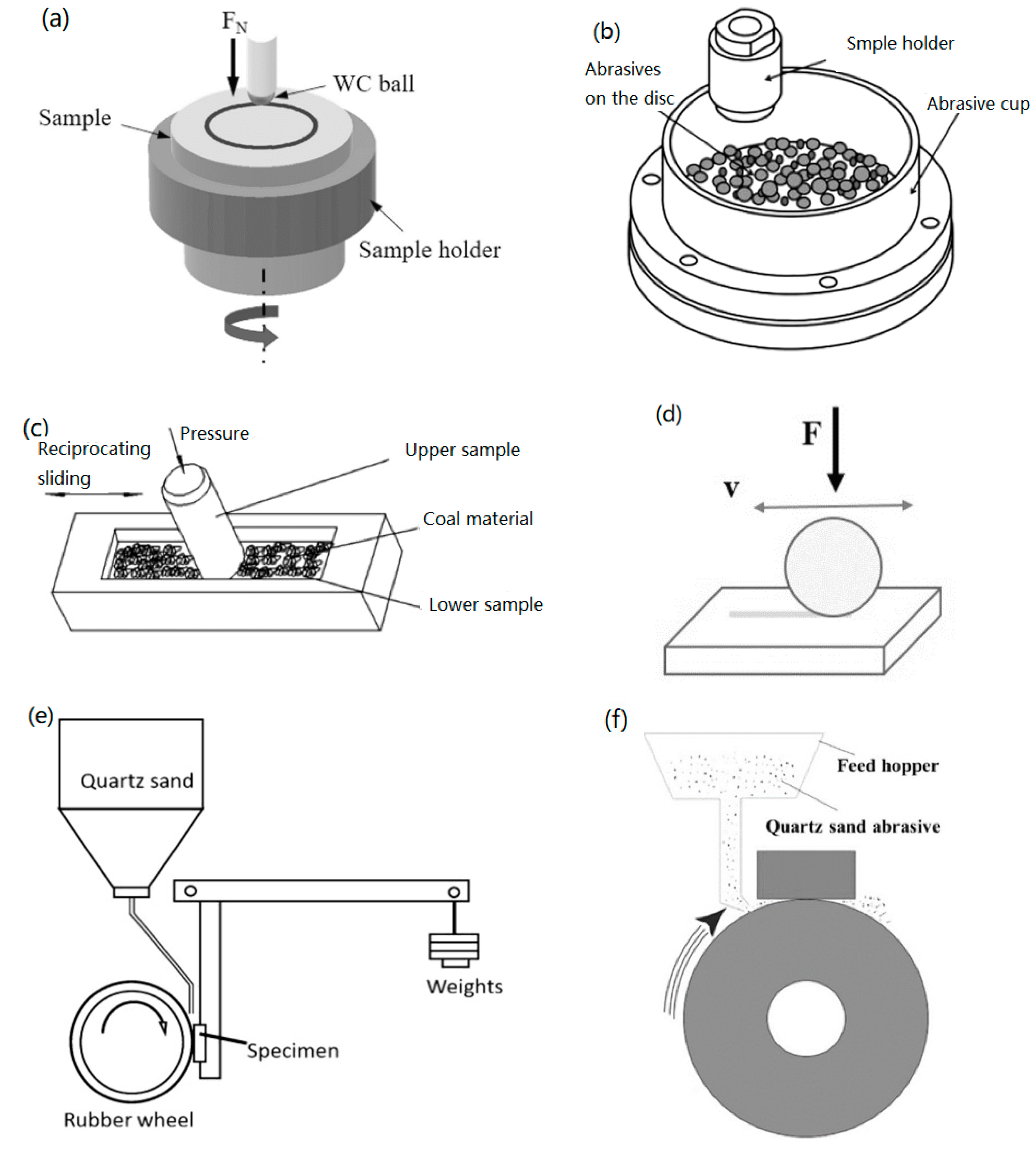

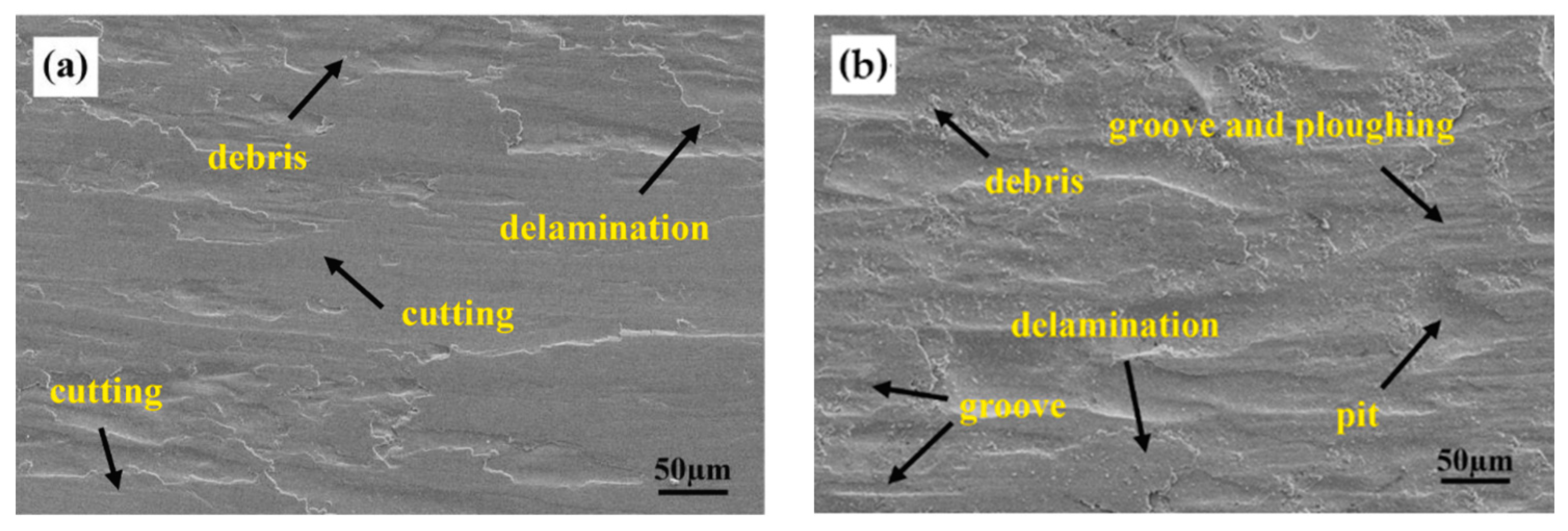
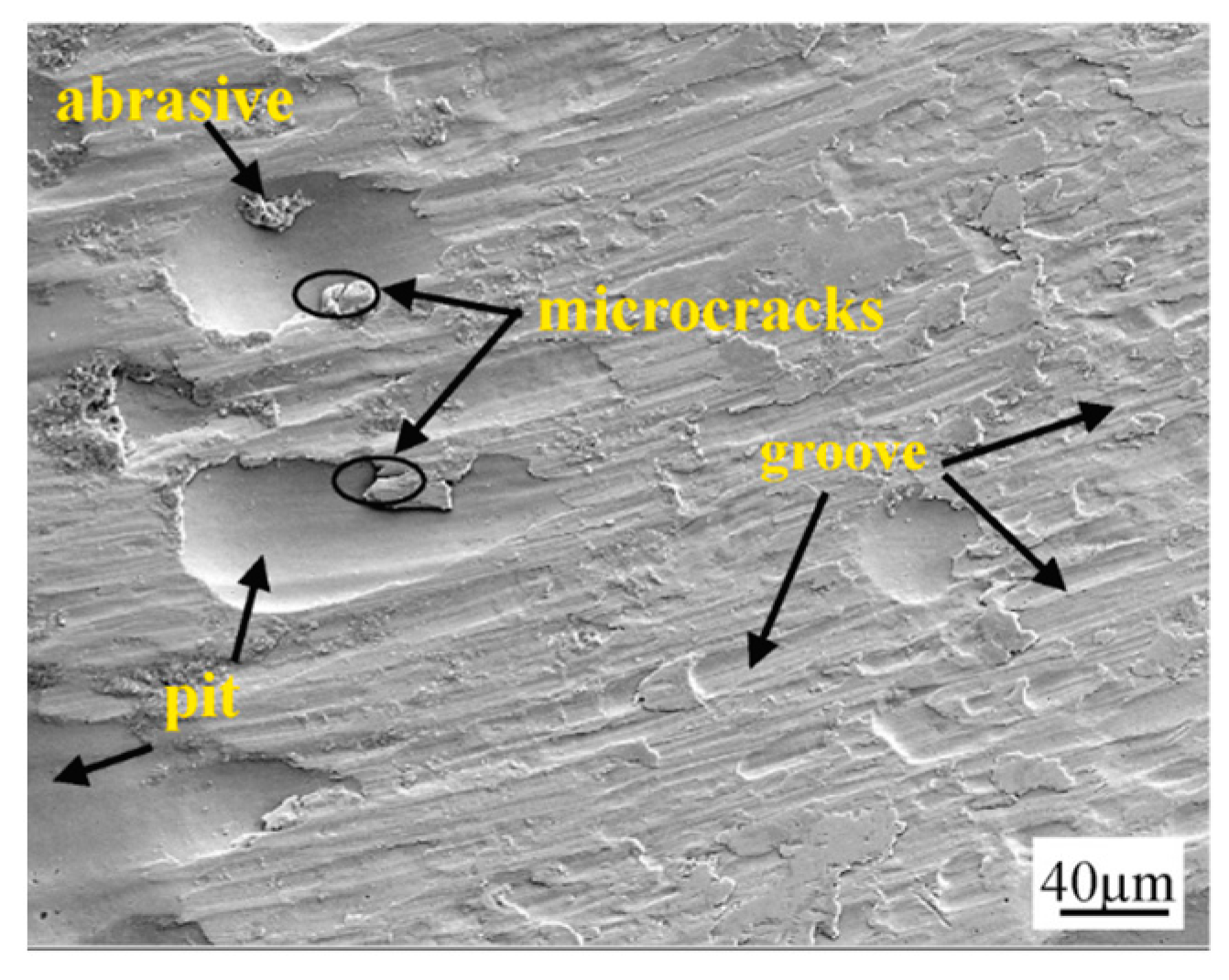
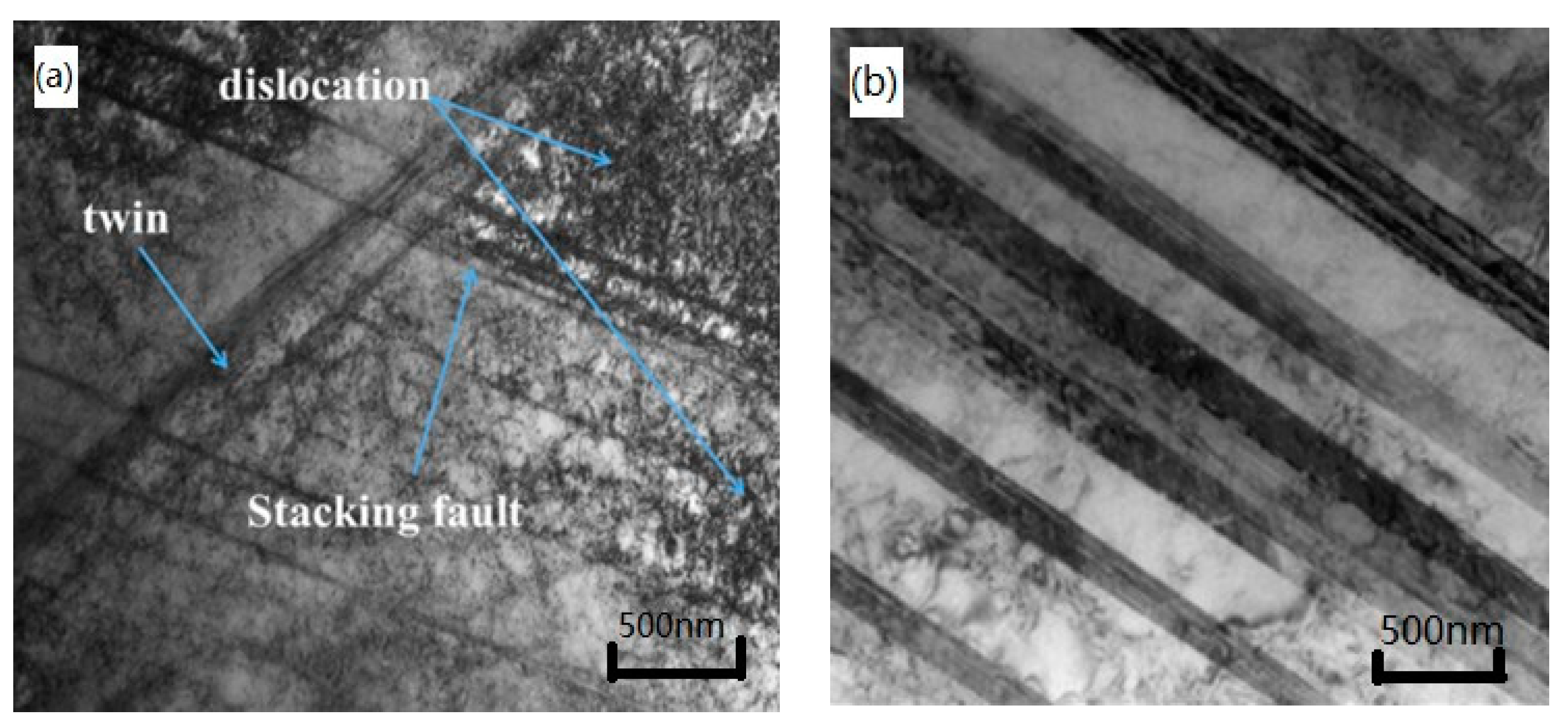

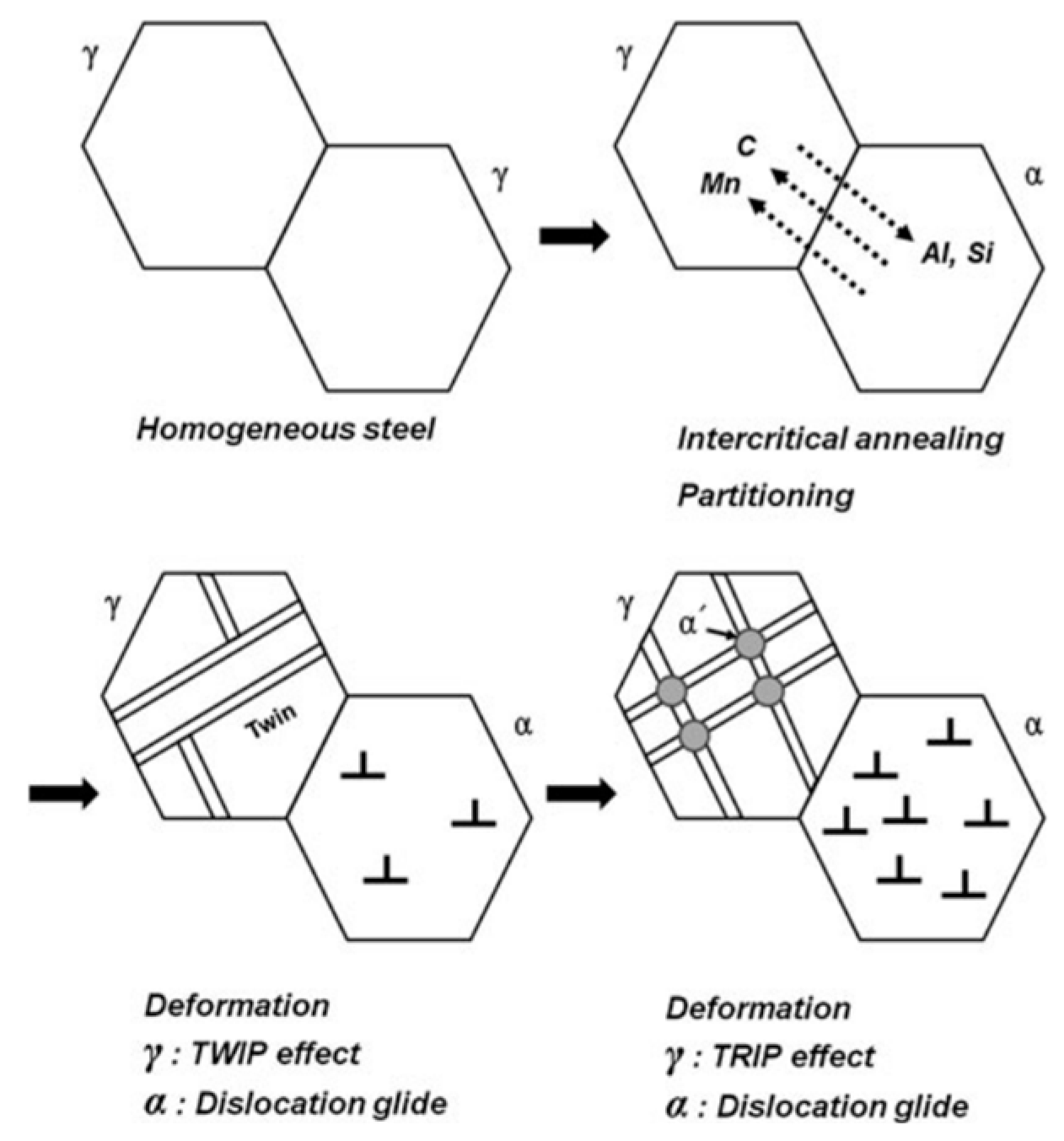
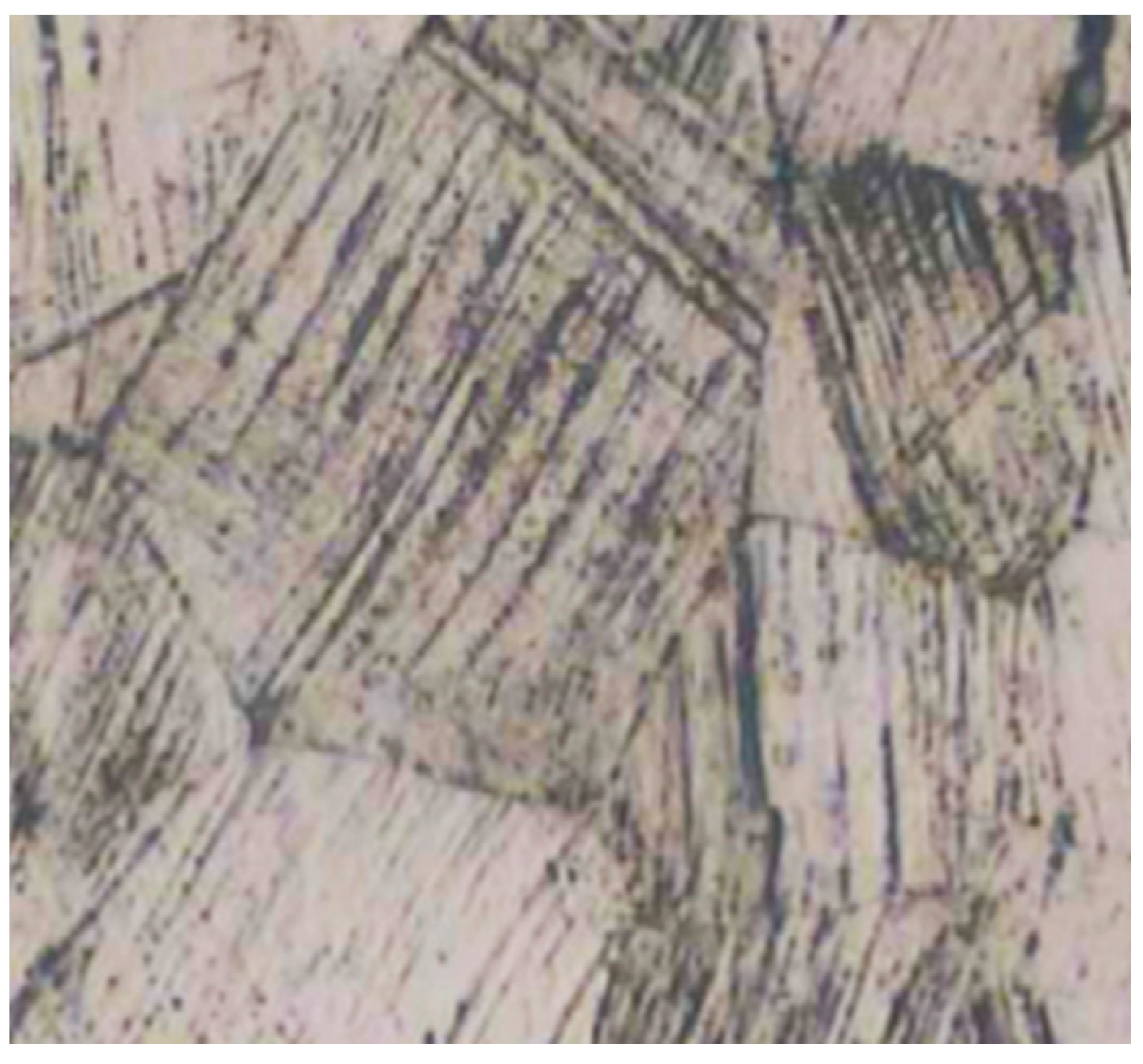
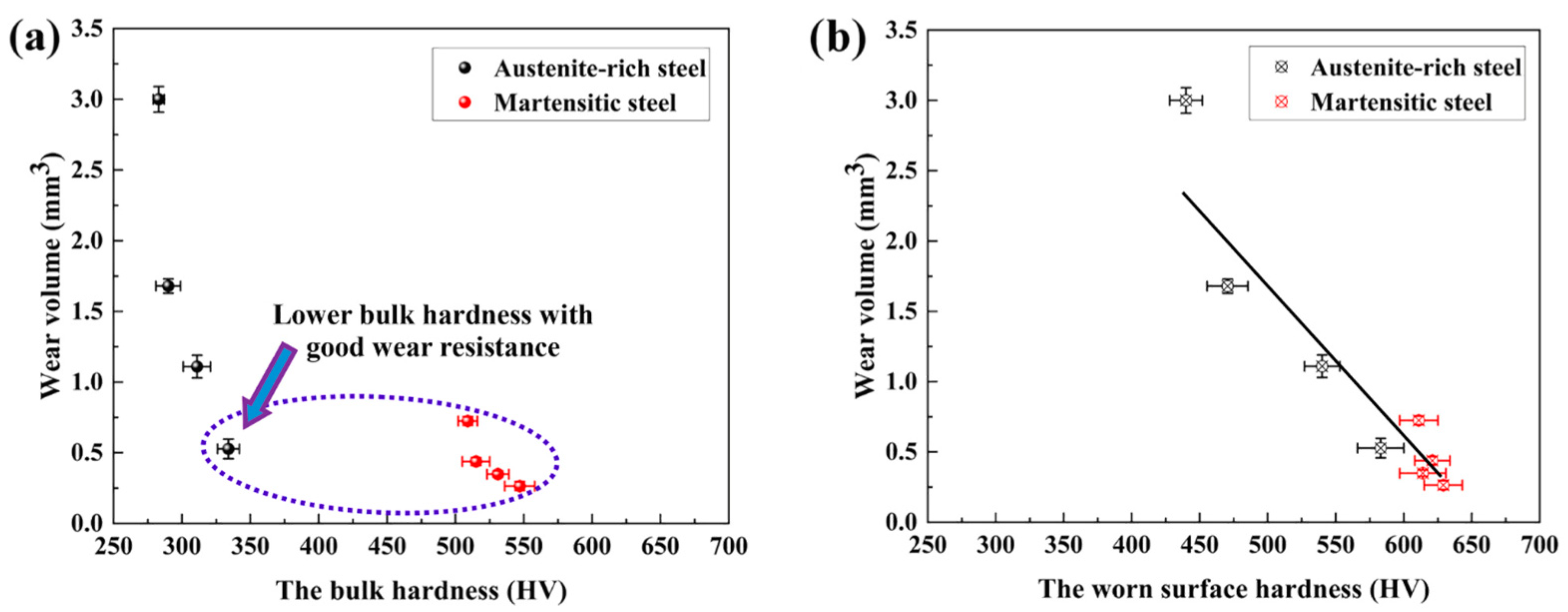
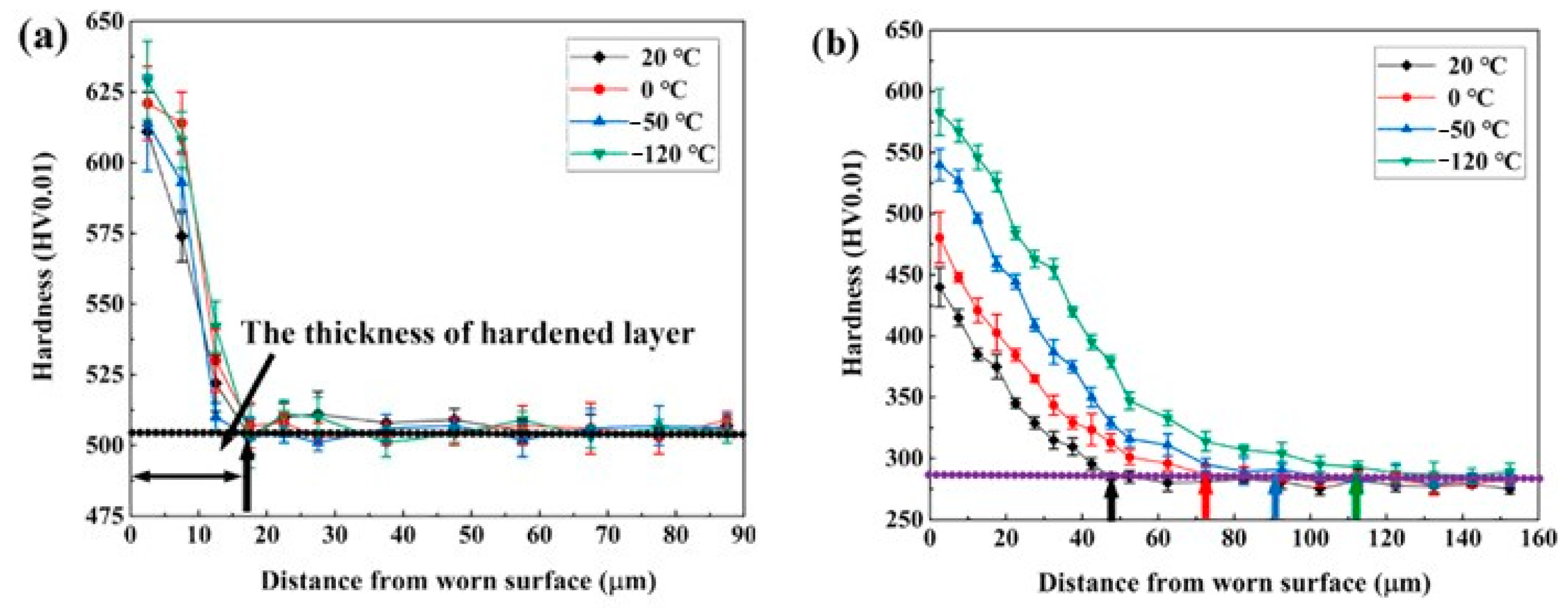
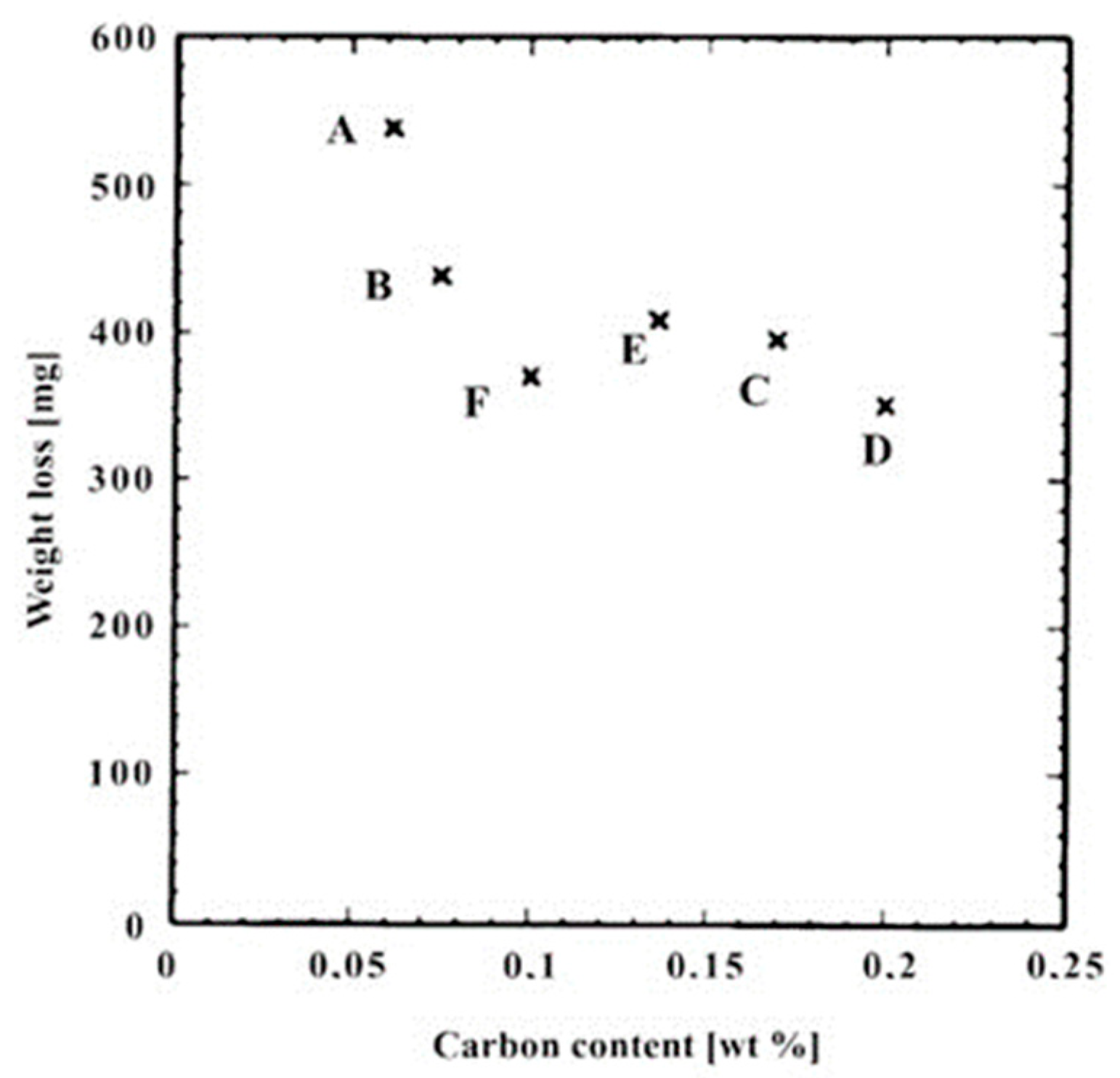

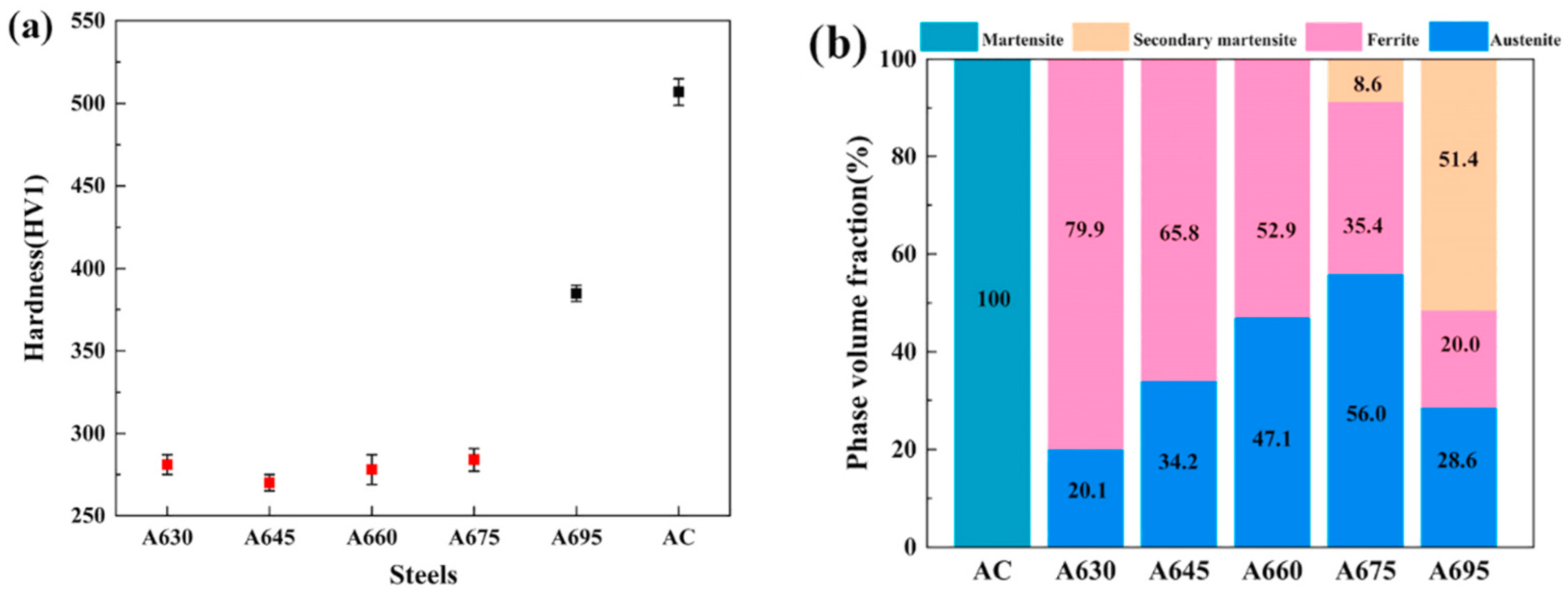
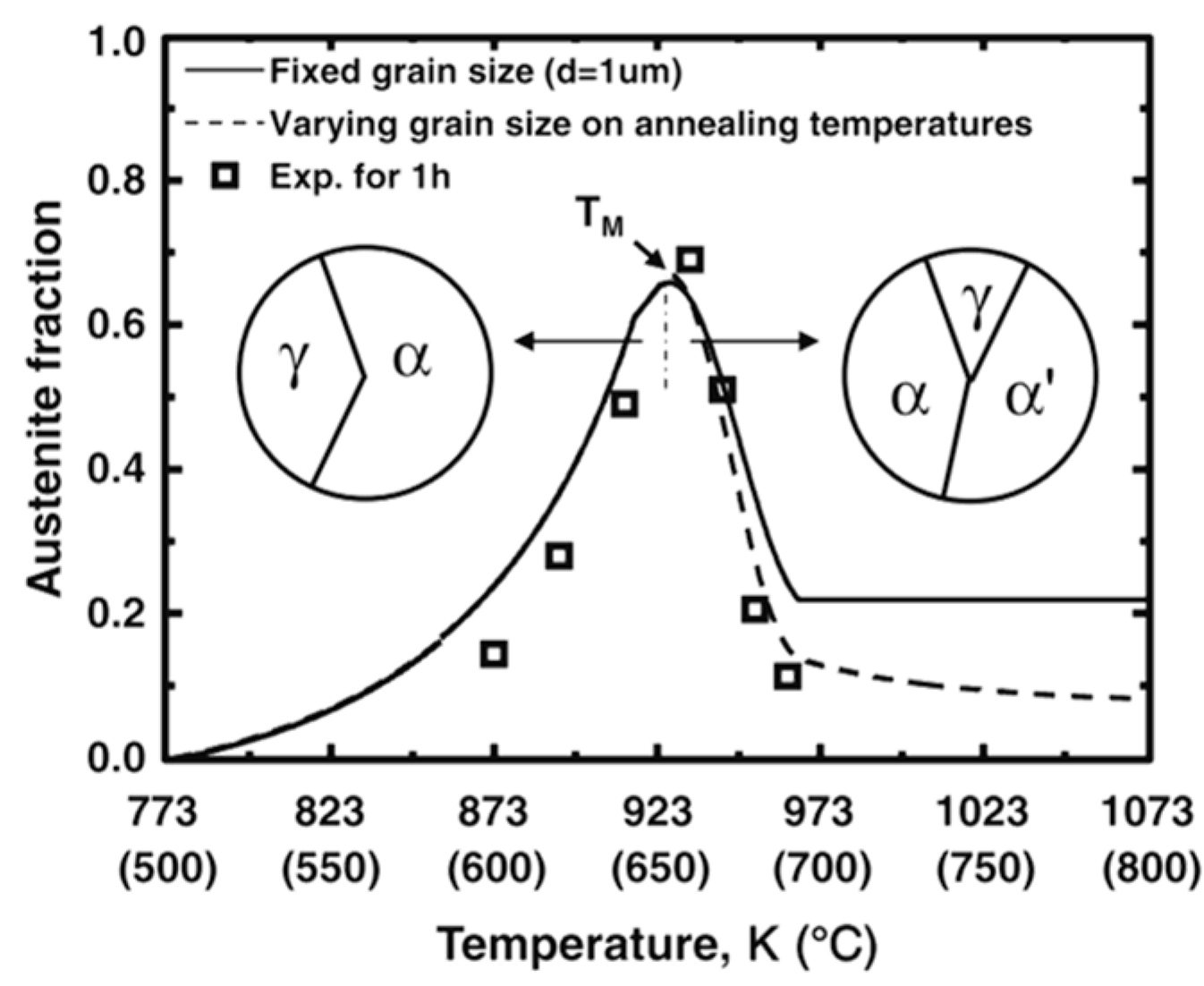

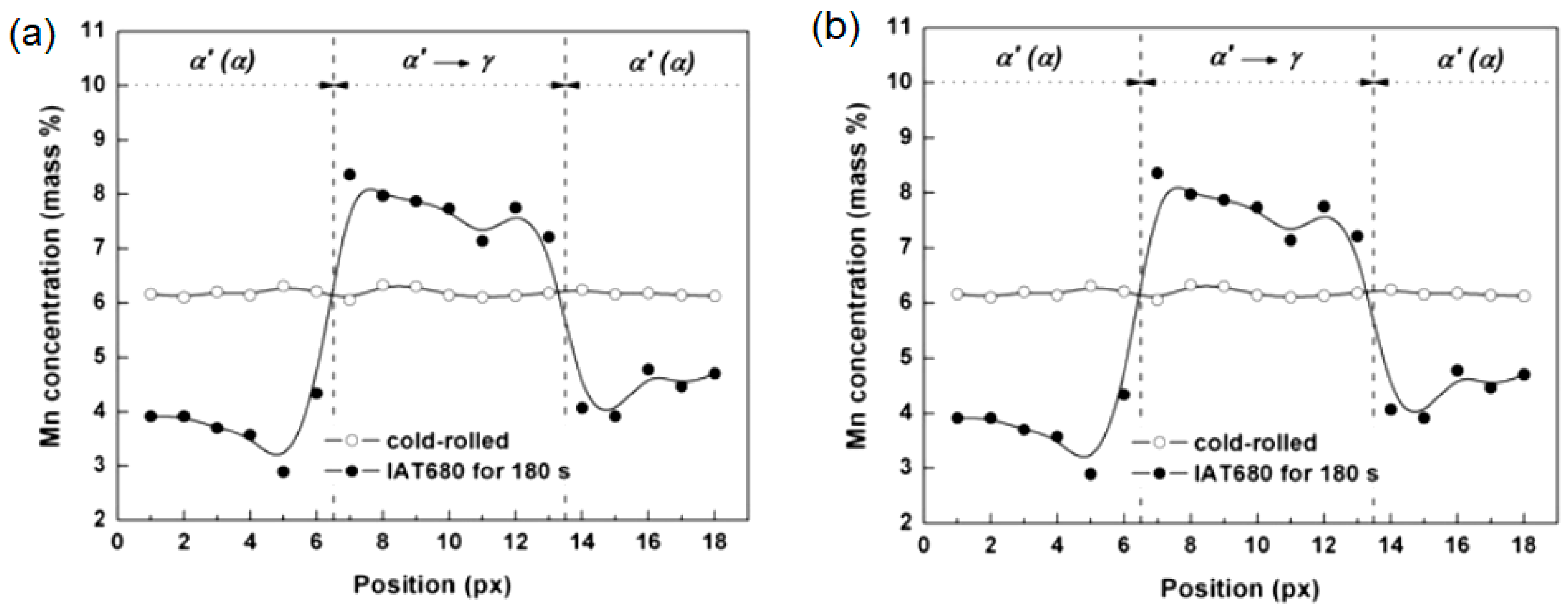

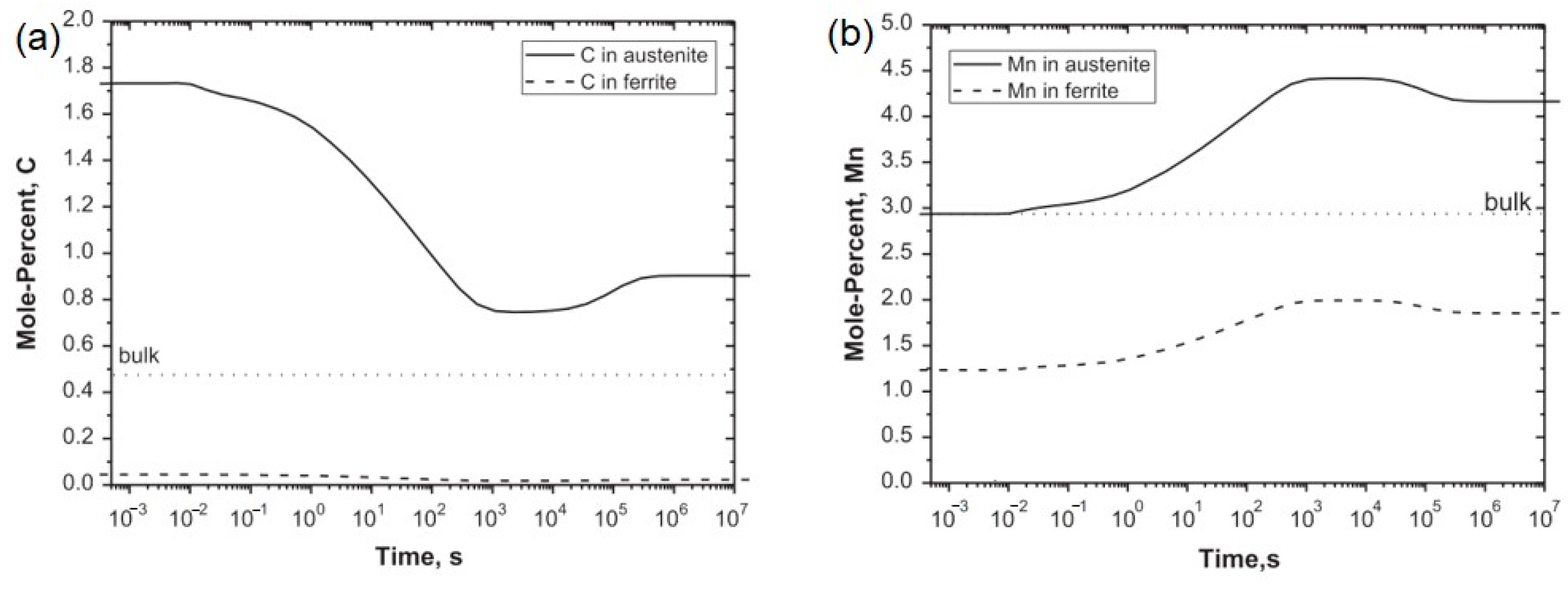

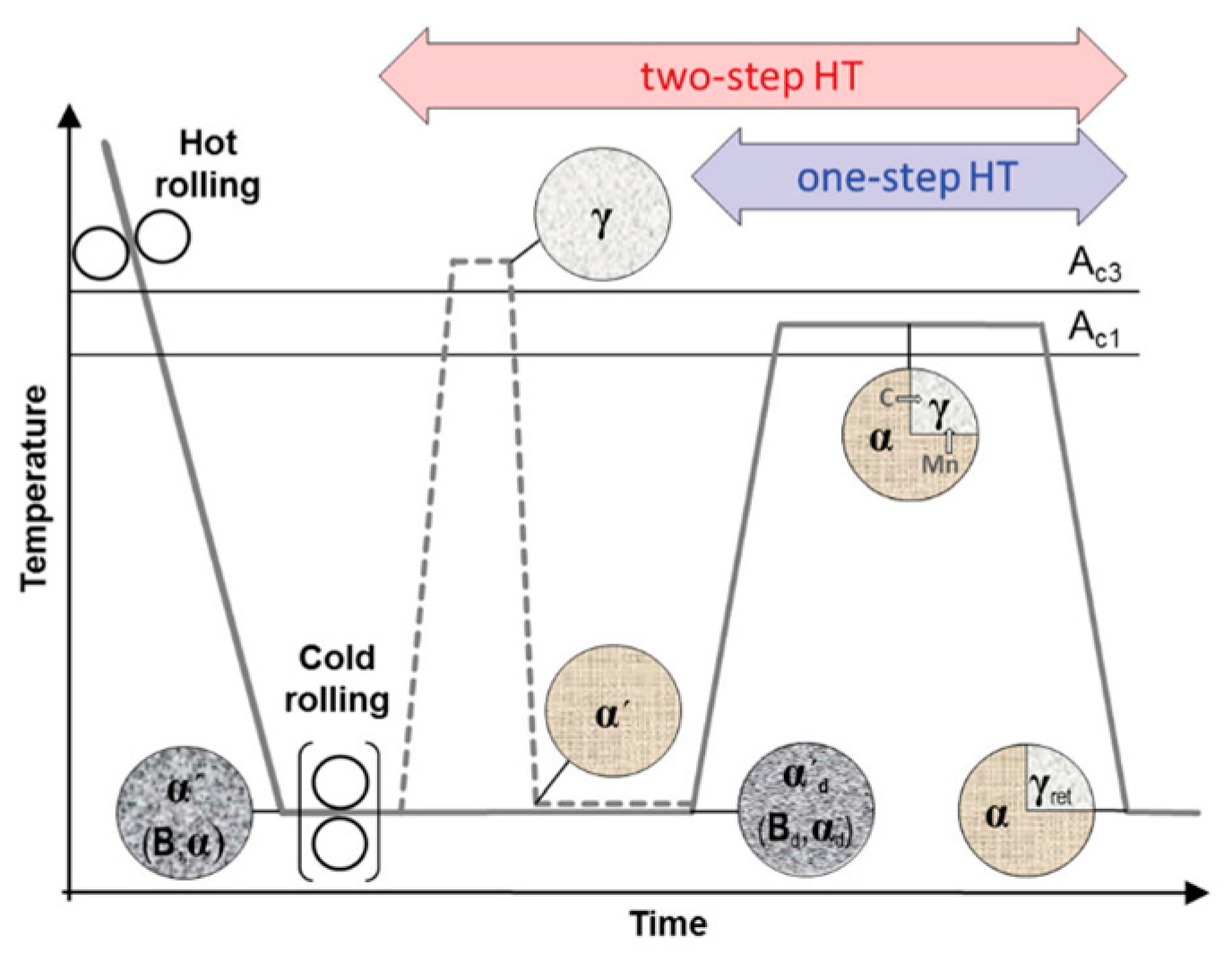

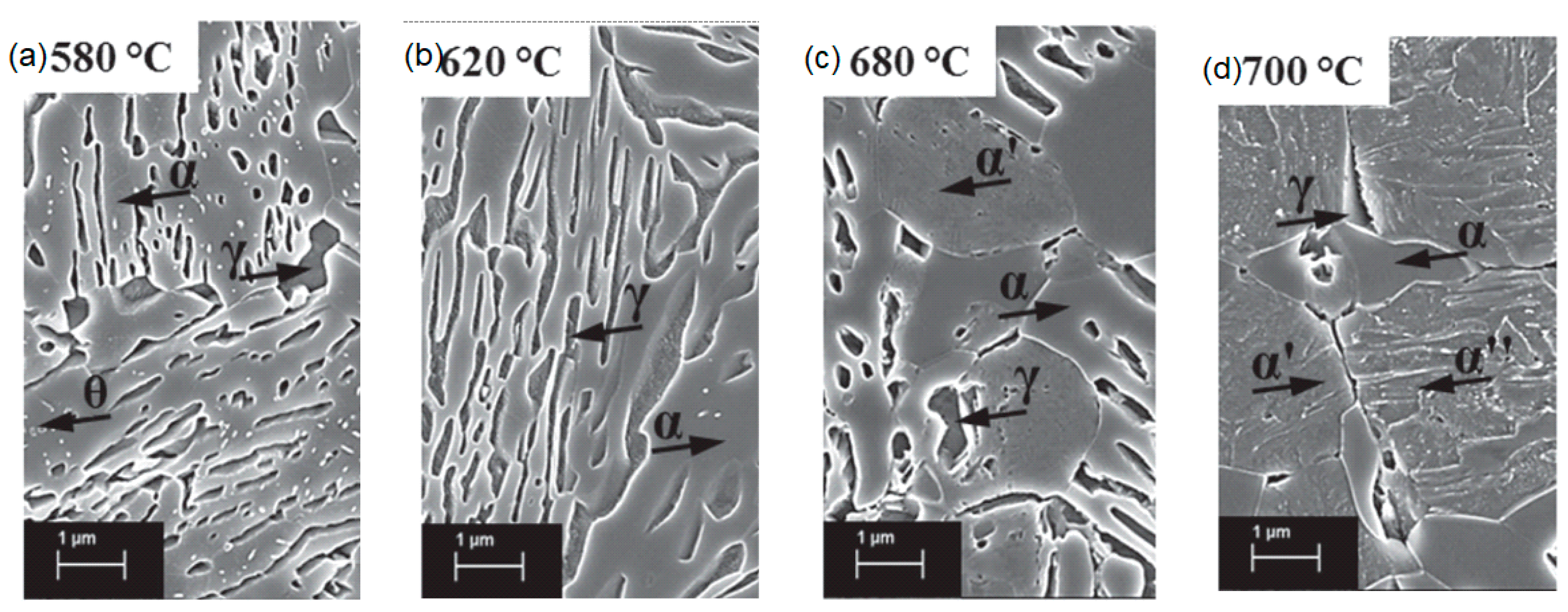



| Materials | Processing Method | Wear Testing Method | Key Result | Mechanism for Enhanced Wear Resistance | Reference |
|---|---|---|---|---|---|
| 0.2 C–5 Mn MMMS, no benchmark steels | Hot rolled and annealed at 630–695 °C | Ball-on-disc dry sliding; 50 N, 60 mm/s, wear distance of 500 m | Samples annealed at 675 °C had the best wear resistance and mechanical properties. | Gradient of strain hardening by austenite-to-martensite transformation | [5] |
| 0.2 C–5 Mn MMMS vs. Hardox 450 MWRS | Hot rolled at FRTs of 700 and 900 °C | Ball-on-disc dry sliding; 25 N, 10 mm/s, 10 min | The mass loss rate of MMMS was 11.9% lower than that of Hardox 450 steel at FRT of 700 °C. | Dislocation and refinement strengthening | [40] |
| 0.91 C–9.0 Mn MMAS vs. MWRS | Hot rolled and water toughened | MLD-10 abrasive wear test using quartz sand particles with impact energies of 1.0, 2.5 and 4.0 J | The wear mass loss of the MMAS decreased approx. 30% compared to that of benchmark steel. | Martensitic transformation, dislocation, and stacking fault at low impact energy; martensitic transformation, deformation twins and dislocation at high impact energy | [6] |
| 0.9 C–9.0 Mn MMAS, no benchmark steels | Hot rolled and water toughened | MLD-10 abrasive wear test using quartz sand particles with impact energies of 0.5 to 6 J | The best and worst wear resistance was obtained at 3.5 and 1.5 J, respectively. | The changes in the amount of martensite and the shapes of dislocation and twins | [2] |
| Mn8 MMAS vs. Mn13 Hadfield steel | Hot rolled and water toughened | Impact and rolling abrasive wear test using quartz sand particles with impact loads of 200 and 400 N | The wear rate of Mn8 was 20% lower than that of Mn13 under different applied loads. | Deformation-induced martensitic transformation, dislocation strengthening and twin strengthening | [3] |
| 0.91 C–8.6 Mn MMAS vs. NM450 MWRS | Hot rolled | Erosion-wear test in various slurry environments | The wear rate of MMAS was 20%-30% lower than that of MWRS. | Martensitic transformation, twin and dislocation strengthening | [41] |
| 0.91 C–9.0 Mn MMAS vs. Hardox 450 MWRS | - | Sliding and impact tribocorrosion tests in simulated acidic mine water | The weight loss and wear rate of MMAS were over 20% lower than those of MMMS in both tests. | Strain-induced martensite transformation, good ability to form passive films and uniform corrosion | [42] |
| 0.3 C–10 Mn–0.25 V MMS vs. Hardox 400 and Hadfield steels | Hot rolled, water quenched at 900 °C, and partitioned at 200 °C | Ball-on-disc dry sliding; 90 N, 60 mm/s, wear distance of 1000 m | The V-containing MMS showed ~3 times higher abrasive wear resistance than the benchmark steels. | Microstructural refinement and improved strain hardening during wear enabled by V element | [43] |
| 1.01 C–7.62 Mn–0 Ti MMAS vs. 0.98 C–7.39 Mn–0.1 Ti MMAS | Hot rolled, solution treated at 1000 °C, and then aged at 500, 550 and 600 °C | Ball-on-disc dry sliding; 50–300 N, 5 Hz, 6 mm, 30 min | The Ti-containing MMAS aged at 500 °C presented the best wear resistance. | ε-martensitic transformation and mechanical twins | [44,45] |
| 760 °C | 780 °C | 800 °C | ||||
|---|---|---|---|---|---|---|
| Austenite | Ferrite | Austenite | Ferrite | Austenite | Ferrite | |
| 120 s | 0.25 | 0.48 | 0.30 | 0.72 | 0.72 | 0.66 |
| 180 s | 1.18 | 2.35 | 1.15 | 2.34 | 2.34 | 2.45 |
Disclaimer/Publisher’s Note: The statements, opinions and data contained in all publications are solely those of the individual author(s) and contributor(s) and not of MDPI and/or the editor(s). MDPI and/or the editor(s) disclaim responsibility for any injury to people or property resulting from any ideas, methods, instructions or products referred to in the content. |
© 2023 by the authors. Licensee MDPI, Basel, Switzerland. This article is an open access article distributed under the terms and conditions of the Creative Commons Attribution (CC BY) license (https://creativecommons.org/licenses/by/4.0/).
Share and Cite
Yan, J.; Zhou, M.; Wu, H.; Liang, X.; Xing, Z.; Li, H.; Zhao, L.; Jiao, S.; Jiang, Z. A Review of Key Factors Affecting the Wear Performance of Medium Manganese Steels. Metals 2023, 13, 1152. https://doi.org/10.3390/met13071152
Yan J, Zhou M, Wu H, Liang X, Xing Z, Li H, Zhao L, Jiao S, Jiang Z. A Review of Key Factors Affecting the Wear Performance of Medium Manganese Steels. Metals. 2023; 13(7):1152. https://doi.org/10.3390/met13071152
Chicago/Turabian StyleYan, Jingru, Muyuan Zhou, Hui Wu, Xiaojun Liang, Zhao Xing, Hongbin Li, Liang Zhao, Sihai Jiao, and Zhengyi Jiang. 2023. "A Review of Key Factors Affecting the Wear Performance of Medium Manganese Steels" Metals 13, no. 7: 1152. https://doi.org/10.3390/met13071152
APA StyleYan, J., Zhou, M., Wu, H., Liang, X., Xing, Z., Li, H., Zhao, L., Jiao, S., & Jiang, Z. (2023). A Review of Key Factors Affecting the Wear Performance of Medium Manganese Steels. Metals, 13(7), 1152. https://doi.org/10.3390/met13071152









